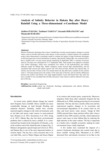Massive freshwater discharges due to heavy rainfall have recently caused negative changes to coastal waters, such as red tides and anoxic water masses. In this research, a salinity analysis was conducted using a three-dimensional σ-coordinate model to evaluate the impact of large freshwater discharges on the horizontal and vertical distribution of salinity. Specifically, Hakata Bay was examined after a heavy rainfall with a six-year return period, beginning 16 September 2002, a common recurrence interval. The data were calculated for 11-27 September 2002. Tank models were applied to calculate river inflow discharges, which were considered river inflow in the hydrodynamic and salinity diffusion model for Hakata Bay. Model validation results showed high reproducibility, and the calculated tidal current and salinity agreed well with observed data. Results also showed that: (1) salinity was less than 15.0 psu at the river mouths about one day after heavy rainfall; (2) low-salinity water (< 28.0 psu) spread across the surface of the inner part of the bay; and (3) salinity differences between the surface and bottom were large (approximately 4 psu) and lasted three days after the heavy rainfall. It was concluded that red tides and anoxic water masses could be induced in the inner part of the bay.

